A Detailed Analysis of the H.B. Robinson-2 Reactor Pressure Vessel Dosimetry Benchmark
Abstract
:1. Introduction
2. The H.B. Robinson-2 Reactor Pressure Vessel Dosimetry Benchmark
2.1. Description of the H.B. Robinson-2 Reactor
2.2. Description of Cycle No. 9 of the H.B. Robinson-2 Reactor
3. Modeling and Methods
3.1. Evaluation of the Fission Neutron Source Term
- The approach: the fission neutron source term was evaluated using only the data provided in the benchmark (no additional calculations were made). This first approach aims to follow as closely as possible the assumptions recommended in [11]. It will be used to put into perspective the results obtained using VACS.
3.1.1. Typical Approximations in Decoupled Approaches
3.1.2. The α Approach: Use of the Data Provided in the Benchmark
3.1.3. The β Approach: Use of VACS
- Main Principles of VACS
- Study-Specific Modeling Approximation
3.2. Modeling Fission Neutron Attenuation from the Core to Sites of Interest
3.2.1. Reactor Geometry
- At 900 K in the fuel;
- At 600 K in the moderator;
- At 600 K in all regions between the reactor core and the vessel (including the RPV);
- At 300 K in all regions outside the vessel.
3.2.2. Modeling of the Dosimeters
- The nuclear data library used to model the neutron transport (ENDF/B-VII.1, ENDF/B-VIII.0 or JEFF-3.3);
- The IRDFF-II (International Reactor Dosimetry and Fusion File) library [31].
3.2.3. Variance Reduction and Simulation Parameters
3.3. Post-Processing of MCNP6 Tally Outputs
4. Results
4.1. Spatial Distribution of Fission Neutrons
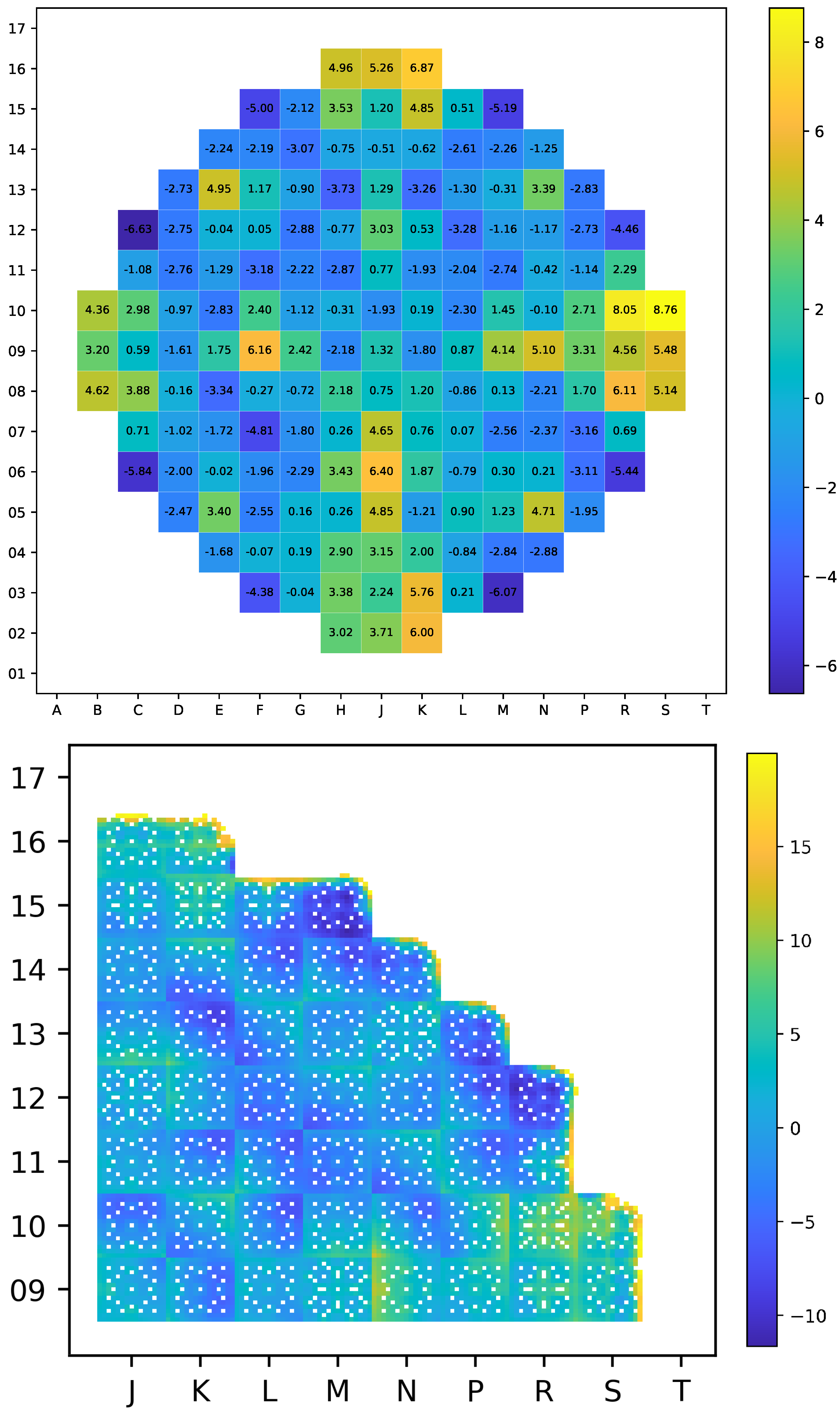
- The methodology employed to evaluate the fission neutron source term in the approach uses the SIMULATE5 code which is based on the diffusion approximation. In comparison, the cycle-averaged power distribution provided in [11] was evaluated from burn-up distributions that were probably obtained by combining experimental data and neutronics calculations.
- The fission neutrons are distributed in the same way as the thermal power in the approach. In contrast, the approach computes the spatial distribution of source neutrons using the fission neutron production rates (product ), which is a more accurate approach in the context of a reactor containing assemblies with various exposures.
- In the approach, the reactor core was modeled as operating at nominal power. However, the power history of the reactor was probably taken into account in the approach.
- Assemblies R09, R10 and R11 are among those that were likely to contain gadolinium-bearing fuel rods, which were not modeled in the approach. Nevertheless, the trends observed here are consistent with the fact that these assemblies could contain gadolinia-bearing fuel rods.
- The nuclear data library used in the approach to evaluate the fission neutron source term (based on ENDF/B-VII.1) probably differs from the one used in the approach.
4.2. Dosimeter Reaction Rates
4.3. Dosimeter Specific Activities
- In the approach, the fission neutron source term was evaluated considering a reactor operating at nominal power. However, it was shown in [8] that predictions of vessel aging are sensitive to the history of the reactor. Therefore, consideration of the reactor power history (and associated control-rod insertions) in the evaluation of the fission neutron source term could improve the C/E predictions.
- As explained in Section 2.2, it is likely that gadolinia-bearing fuel pins were used during cycle no. 9, and these were not modeled in the approach. Modeling these gadolinia-bearing fuel pins could result in an improvement in the C/E predictions.
- In the MCNP6 model, the moderator density gradients in the reactor core and in the moderator bypass zones were not modeled. However, in [6], the authors indicate that such assumptions can lead to a significant bias in vessel aging predictions. Therefore, modeling the moderator density gradients could improve the accuracy of C/E estimates.
- The surveillance capsule modeling could be reworked to better match the data provided in [11], which could also lead to a very slight improvement in the obtained results.
5. Conclusions
Author Contributions
Funding
Institutional Review Board Statement
Informed Consent Statement
Data Availability Statement
Acknowledgments
Conflicts of Interest
Abbreviations
| HBR-2 | H.B. Robinson-2 |
| IRSN | Institut de Radioprotection et de Sûreté Nucléaire |
| PWR | Pressurized Water Reactor |
| RPV | Reactor Pressure Vessel |
| VACS | Vessel Aging Calculation Scheme developed at IRSN |
References
- Pichon, C.; Brillaud, C.; Deydie, D.; Alberman, A.; Soulat, P. Chapter Neutron Spectrum Effect and Damage Analysis on Pressure Vessel Steel Irradiation Behaviour; ASTM International: West Conshohocken, PA, USA, 2000; pp. 87–97. [Google Scholar]
- Wagner, J.C.; Haghighat, A.; Petrovic, B.G. Monte Carlo Transport Calculations and Analysis for Reactor Pressure Vessel Neutron Fluence. Nucl. Technol. 1996, 114, 373–398. [Google Scholar] [CrossRef]
- Vasiliev, A.; Ferroukhi, H.; Zimmermann, M.A.; Chawla, R. Development of a CASMO-4/SIMULATE-3/MCNPX calculation scheme for PWR fast neutron fluence analysis and validation against RPV scraping test data. Ann. Nucl. Energy 2007, 34, 615–627. [Google Scholar] [CrossRef]
- Matsushita, K.; Kurosawa, M. Neutron fluence analyses around the reactor pressure vessel of BWR using MCNP with a heterogeneous and homogeneous mixed core model. Prog. Nucl. Sci. Technol. 2014, 4, 463–466. [Google Scholar] [CrossRef]
- Bourganel, S.; Petit, O.; Diop, C. Three-Dimensional Particle Transport Using Green’s Functions in TRIPOLI-4 Monte Carlo Code: Application to PWR Neutron Fluence and Ex-Core Response Studies. Nucl. Technol. 2013, 184, 29. [Google Scholar] [CrossRef]
- Vuiart, R.; Brovchenko, M.; Taforeau, J.; Jaiswal, V.; Dumonteil, E. A Versatile Methodology for Reactor Pressure Vessel Aging Assessments. Nucl. Sci. Eng. 2022, 196, 455–477. [Google Scholar] [CrossRef]
- Vuiart, R.; Console Camprini, P.; Burn, K.; Brovchenko, M.; Taforeau, J.; Dumonteil, E. Impact of Fission Spectrum Modeling on Aging Estimations of Pressurized Water Reactor Vessels. Trans. Am. Nucl. Soc. 2021, 125, 1106–1109. [Google Scholar] [CrossRef]
- Vuiart, R.; Brovchenko, M.; Taforeau, J. Impact of core power variations on the fast neutron flux incident on pressurized water reactor vessels. In Proceedings of the 2019 International Congress on Advances in Nuclear Power Plants (ICAPP 2019), Juan-les-Pins, France, 12–15 May 2019. [Google Scholar]
- Vuiart, R. Analyse du Vieillissement Sous Irradiation Neutronique des Cuves des Réacteurs Nucléaires à eau sous Pression. Ph.D. Thesis, Université Paris-Saclay, Fontenay-aux-Roses, France, 2021. [Google Scholar]
- Benedet, B.; Vuiart, R.; Taforeau, J.; Brovchenko, M. Sensitivity of Pressurized Water Reactors Vessels Aging to Fuel Composition. Trans. Am. Nucl. Soc. 2021, 125, 1110–1113. [Google Scholar] [CrossRef]
- Remec, I.; Kam, F. H.B. Robinson-2 Pressure Vessel Benchmark; NUREF/CR-6453, ORNL/TM-13204; Oak Ridge National Laboratory: Oak Ridge, TN, USA, 1997. [Google Scholar]
- Kodeli, I.; Sartori, E. SINBAD–Radiation shielding benchmark experiments. Ann. Nucl. Energy 2021, 159, 108254. [Google Scholar] [CrossRef]
- Pittarello, R.; Vasiliev, A.; Ferroukhi, H.; Chawla, R. Refined Monte Carlo analysis of the H.B. Robinson-2 reactor pressure vessel dosimetry benchmark. Ann. Nucl. Energy 2011, 38, 1842–1851. [Google Scholar] [CrossRef]
- Vasiliev, A.; Ferroukhi, H.; Kolbe, E. Performance of a Monte-Carlo solution for the H.B. Robinson-2 Pressure Vessel Dosimetry Benchmark. Ann. Nucl. Energy 2010, 37, 1404–1410. [Google Scholar] [CrossRef]
- Orsi, R. H.B. Robinson-2 pressure vessel dosimetry benchmark: Deterministic three-dimensional analysis with the TORT transport code. Nucl. Eng. Technol. 2019, 52, 448–455. [Google Scholar] [CrossRef]
- Bourganel, S.; Raskiniteb, I.; Soldevilac, M. Analysis of the H.B. ROBINSON-2 reactor pressure vessel dosimetry benchmark using TRIPOLI-4 Monte Carlo code. Prog. Nucl. Sci. Technol. 2014, 4, 312–316. [Google Scholar] [CrossRef]
- HBR-2-Updated Final Safety Analysis Report-CHAPTER 4, Carolina Power & Light Document, Hosted by NRC, Washington D.C. Revision No. 21. Available online: https://www.nrc.gov/docs/ML1729/ML17298A851.pdf.
- Macfarlane, R.; Muir, D.; Boicourt, R.M.; Kahler, A.C., III; Conlin, J.L. The NJOY Nuclear Data Processing System, Version 2016; Technical Report for Los Alamos National Lab. (LANL): Los Alamos, NM, USA, 2017. [Google Scholar] [CrossRef] [Green Version]
- Plompen, A.J.; Cabellos, O.; De Saint, J.C.; Fleming, M.; Algora, A.; Angelone, M.; Archier, P.; Bauge, E.; Bersillon, O.; Blokhin, A.; et al. The joint evaluated fission and fusion nuclear data library, JEFF-3.3. Eur. Phys. J. 2020, 56, 181. [Google Scholar] [CrossRef]
- Rhodes, J.; Hykes, J.; Ferrer, R. CASMO5 a Fuel Assembly Burnup Program User’s Manual; Studsvik Scandpower Inc.: Idaho Falls, ID, USA, 2017; Rev. 12. [Google Scholar]
- Bahadir, T.; Lindahl, S. Studsvik’s next generation nodal code SIMULATE-5. In Proceedings of the Advances in Nuclear Fuel Management IV (ANFM 2009), Hilton Head Island, SC, USA, 12–15 April 2009. [Google Scholar]
- Williams, M.L. DOTSOR: A Module in the LEPRICON Computer Code System for Representing the Neutron Source Distribution in LWR Cores; EPRI Research Project: 1399-1 Interim Report, RSIC Peripheral Shielding Routine Collection PSR-277; EPRI: Washington, DC, USA, 1985. [Google Scholar]
- Goorley, T.; James, M.; Booth, T.; Brown, F.; Bull, J.; Cox, L.; Durkee, J.; Elson, J.; Fensin, M.; Forster, R.; et al. Initial MCNP6 Release Overview - MCNP6 Version 1.0. Nucl. Technol. 2013, 164. [Google Scholar] [CrossRef]
- Chadwick, M.; Herman, M.; Obložinský, P.; Dunn, M.E.; Danon, Y.; Kahler, A.C.; Smith, D.L.; Pritychenko, B.; Arbanas, G.; Arcilla, R.; et al. ENDF/B-VII.1 Nuclear Data for Science and Technology: Cross Sections, Covariances, Fission Product Yields and Decay Data. Nucl. Data Sheets 2011, 112, 2887–2996. [Google Scholar] [CrossRef]
- Hébert, A. Applied Reactor Physics. In Presses Internationales Polytechnique; Worldcat: Montréal, QC, Canada, 2009; ISBN 978-2-553-01436-9. [Google Scholar]
- Bahadir, T.; Lindahl, S.; Scandpower, S. SIMULATE-4 Pin Power Calculation. In Proceedings of the PHYSOR-2006 American Nuclear Society’s Topical Meeting on Reactor Physics: Organized and Hosted by the Canadian Nuclear Society, Vancouver, BC, Canada, 10–14 September 2006. [Google Scholar]
- Initial MCNP6 Release Overview. Nucl. Technol. 2012, 180, 298–315. [CrossRef]
- Fonte, L. Modélisation et Analyse du Benchmark SINBAD du Réacteur H.B. Robinson-2; AERGON, Internal IRSN Report: Fontenay-aux-Roses, France, 2021. [Google Scholar]
- Skutnik, S. ORIGEN-Based Nuclear Fuel Inventory Module for Fuel Cycle- Assessment Final Project Report; Department of Nuclear Engineering, University of Tennessee-Knoxville: Knoxville, TN, USA, 2017. [Google Scholar]
- Brown, D.; Chadwick, M.; Capote, R.; Kahler, A.; Trkov, A.; Herman, M.; Sonzogni, A.; Danon, Y.; Carlson, A.; Dunn, M.; et al. ENDF/B-VIII.0: The 8th Major Release of the Nuclear Reaction Data Library with CIELO-project Cross Sections, New Standards and Thermal Scattering Data. Nucl. Data Sheets 2018, 148, 1–142. [Google Scholar] [CrossRef]
- Trkov, A.; Griffin, P.; Simakov, S.; Greenwood, L.; Zolotarev, K.; Capote, R.; Aldama, D.; Chechev, V.; Destouches, C.; Kahler, A.; et al. IRDFF-II: ANew Neutron Metrology Library. Nucl. Data Sheets 2020, 163, 1–108. [Google Scholar] [CrossRef]
- Mosher, S.; Johnson, S.; Bevill, A.; Ibrahim, A.; Daily, C.; Evans, T.; Wagner, J.; Johnson, J.; Grove, R. ADVANTG—An Automated Variance Reduction Parameter Generator, Rev. 1; Oak Ridge National Lab. (ORNL): Oak Ridge, TN, USA, 2015. [Google Scholar]
- Evans, T.; Stafford, A.; Slaybaugh, R.; Clarno, K. DENOVO: A New Three-Dimensional Parallel Discrete Ordinates Code in SCALE. Nucl. Technol. 2010, 171, 171–200. [Google Scholar] [CrossRef]
- Wagner, J.; Haghighat, A. Automated Variance Reduction of Monte Carlo Shielding Calculations Using the Discrete Ordinates Adjoint Function. Nucl. Sci. Eng. 1998, 128, 186–208. [Google Scholar] [CrossRef]
- Rhoades, W.; Childs, R. The DORT Two-Dimensional Discrete Ordinates Transport Code. Nucl. Sci. Eng. 1988, 99, 88–89. [Google Scholar] [CrossRef]
- White, J.; Ingersoll, D.; Skater, C.; Roussin, R. BUGLE-96: A Revised Multigroup cross Section Library for LWR Applications based On ENDF/B-VI Release 3. In Proceedings of the ANS Radiation Protection & Shielding Topical Meeting, Falmouth, MA, USA, 21–25 April 1996. [Google Scholar]
- Fischer, A. Benchmarking of ENDF/B-VIII.0 Cross Sections for LWR Ex-Core Transport Applications. In Proceedings of the PHYSOR 2022, Pittsburgh, PA, USA, 15–20 May 2022. [Google Scholar]
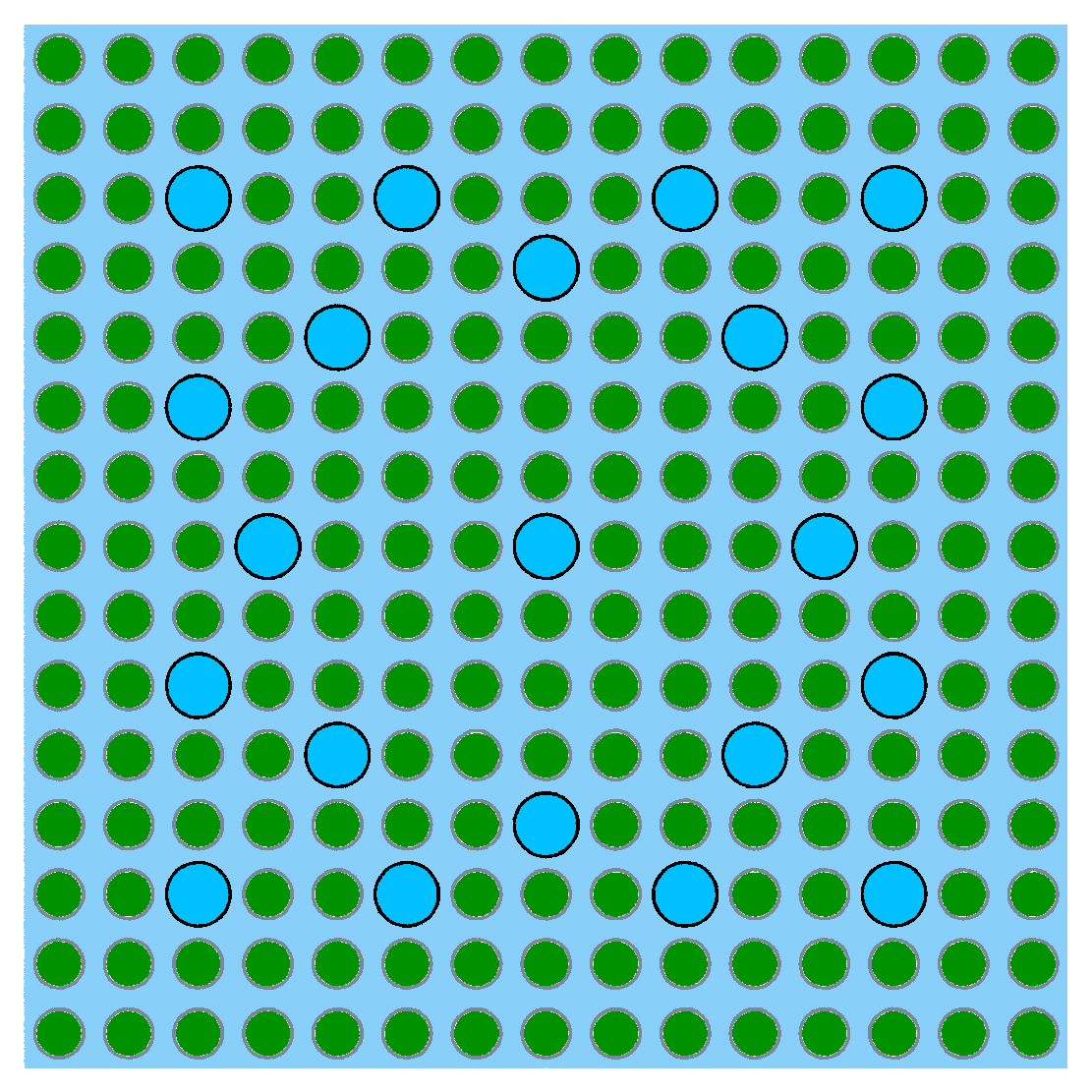


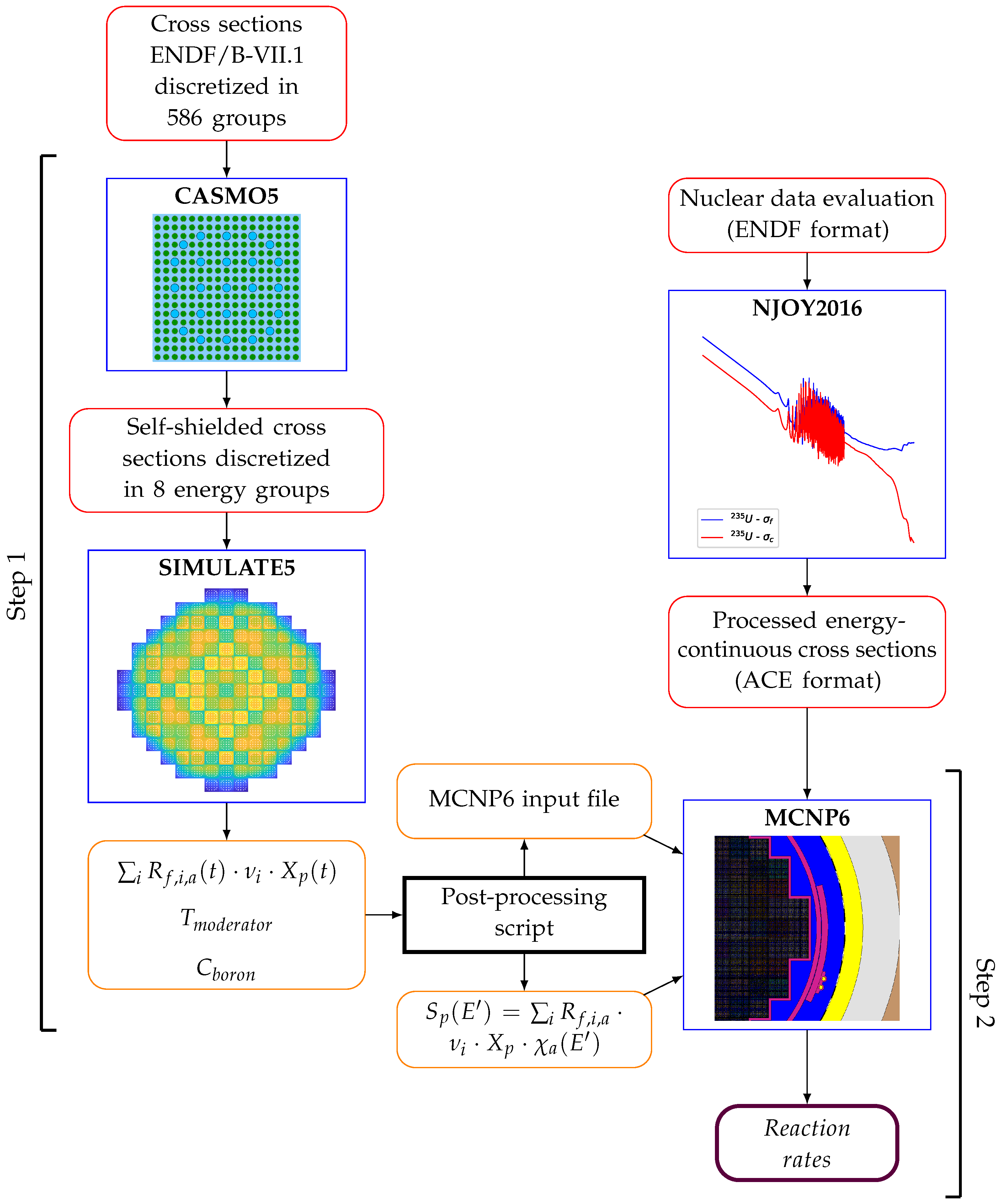

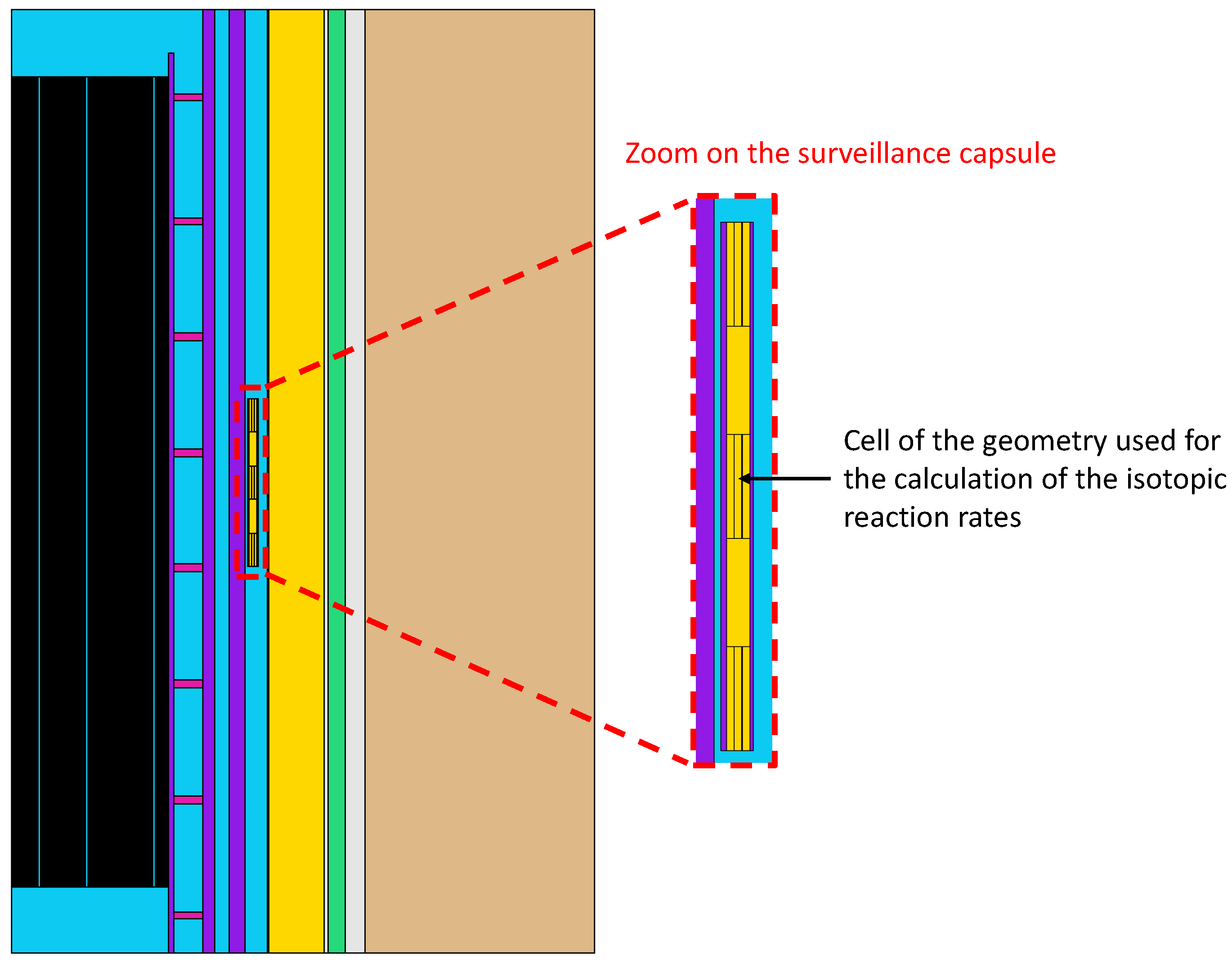

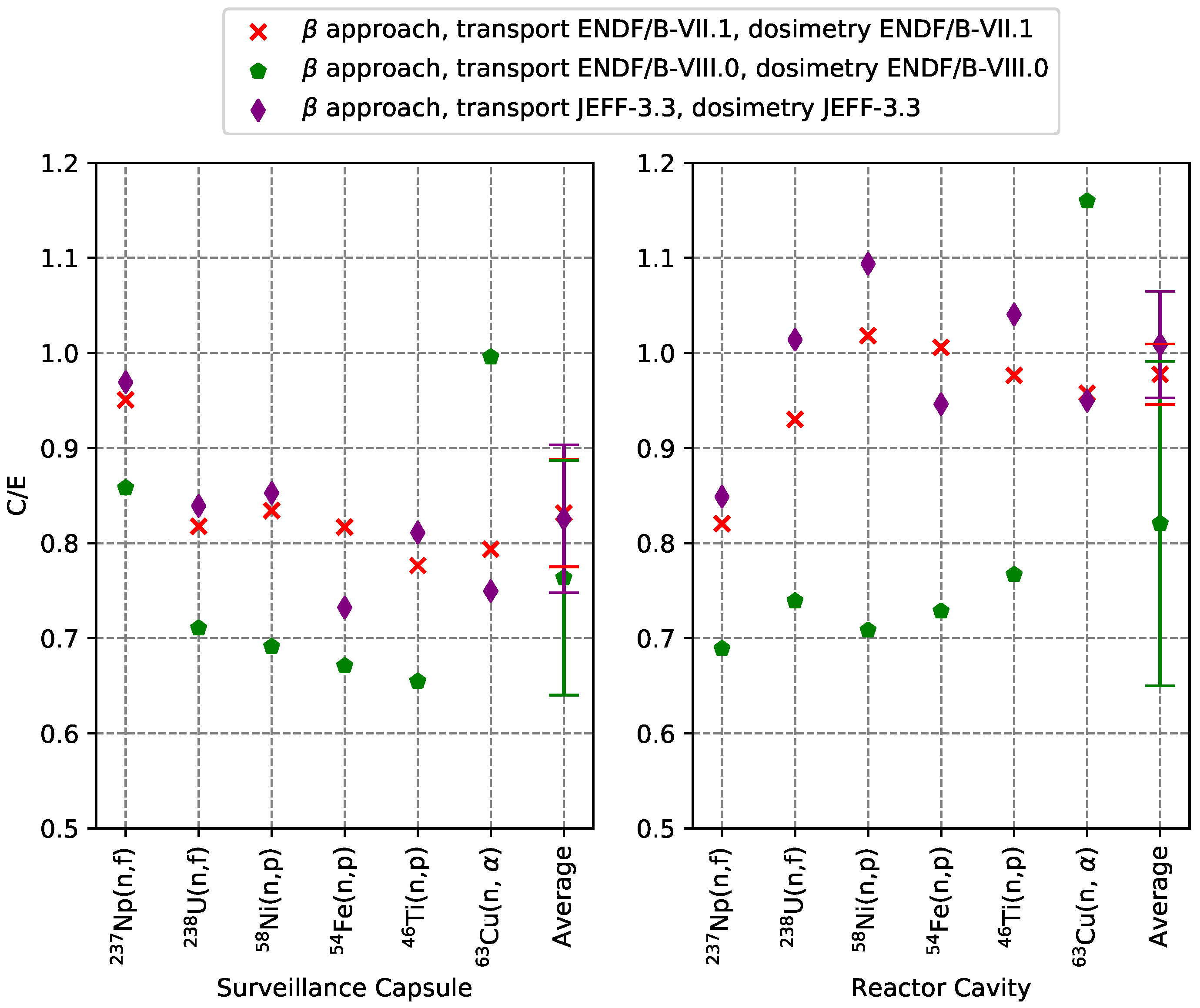
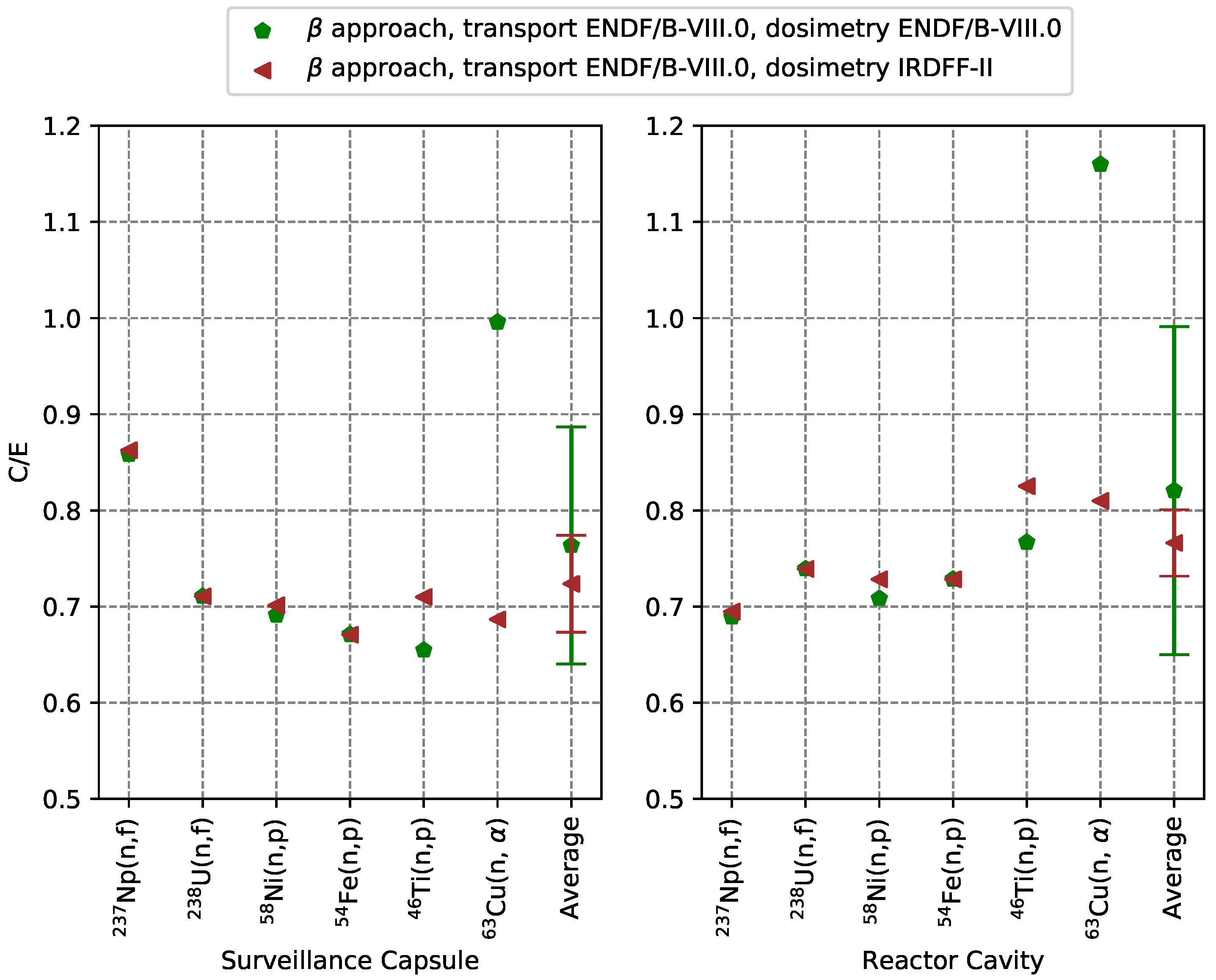
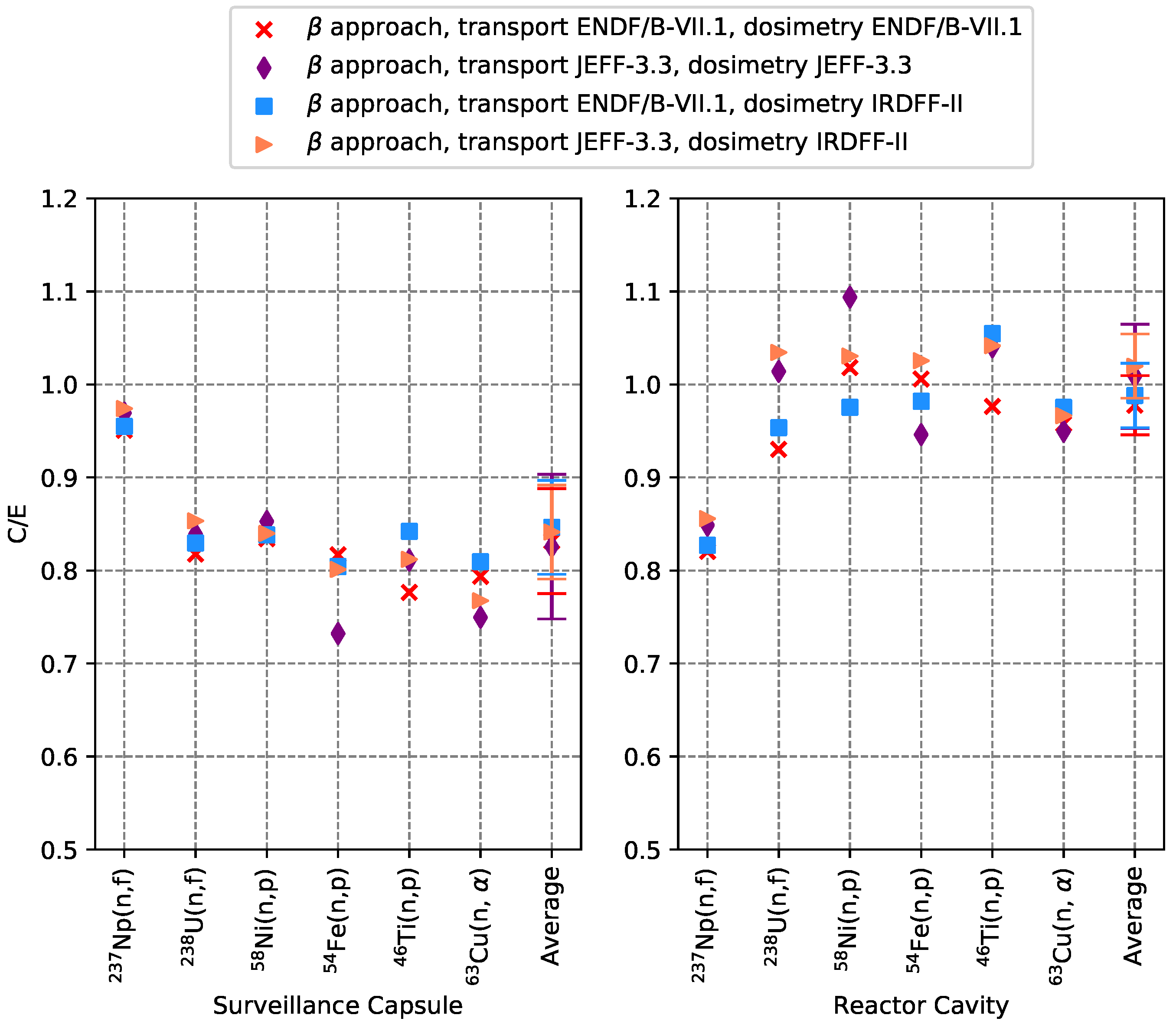
| Dosimeter Location | |||
|---|---|---|---|
| Dosimeter Type | Capsule | Reactor Cavity | |
| Specific activities (Bq/mg) | Np(n,f)Cs | 3.671 | 2.236 |
| U(n,f)Cs | 5.345 | 8.513 | |
| Ni(n,p)Co | 1.786 | 1.959 | |
| Fe(n,p)Mn | 9.342 | 8.711 | |
| Ti(n,p)Sc | 3.500 | 3.310 | |
| Cu(n,)Co | 2.646 | 2.645 | |
| Nuclide | Incident Neutron Energy | Fission Spectrum Type | a (MeV) | b (MeV) |
|---|---|---|---|---|
| U | Thermal | Watt | 0.988 | 2.249 |
| U | 2.6 MeV | Watt | 0.920 | 3.121 |
| Pu | Thermal | Watt | 0.966 | 2.842 |
| Pu | Thermal | Maxwell | 1.3597 | - |
| Isotope | Atomic Density () |
|---|---|
| Fe | 5.13 |
| Cu | 5.88 |
| Ni | 6.26 |
| Ti | 4.707 |
| Np | 5.081 |
| U | 4.75 |
| Dosimeter Location | |||
|---|---|---|---|
| Reaction | Surveillance Capsule | Reactor Cavity | |
() | Np(n,f)Cs | ||
| U(n,f)Cs | |||
| Ni(n,p)Co | |||
| Fe(n,p)Mn | |||
| Ti(n,p)Sc | |||
| Cu(n,)Co | |||
| Surveillance Capsule Reaction Rates (Reactions atom) | ||||||||
|---|---|---|---|---|---|---|---|---|
| Methodology | Nuclear Data— Attenuation | Nuclear Data— Dosimetry | Np(n,f) | U(n,f) | Ni(n,p) | Fe(n,p) | Ti(n,p) | Cu(n,) |
| Remec and Kam–DORT [11] | BUGLE-96 | 1.06 | 1.54 | 4.74 | 3.51 | 5.62 | 3.57 | |
| approach and MCNP6 | ENDF/B-VII.1 | ENDF/B-VII.1 | 1.07 (0.55) | 1.37 (0.68) | 4.12 (0.87) | 3.04 (0.94) | 5.04 (1.41) | 2.96 (1.85) |
| IRDFF-II | 1.07 (0.55) | 1.39 (0.67) | 4.15 (0.90) | 3.00 (0.97) | 5.47 (1.40) | 3.02 (1.84) | ||
| approach and MCNP6 | ENDF/B-VII.1 | ENDF/B-VII.1 | 1.04 (0.58) | 1.41 (0.72) | 4.17 (0.93) | 3.06 (0.99) | 5.07 (1.54) | 3.06 (2.05) |
| IRDFF-II | 1.11 (0.58) | 1.43 (0.72) | 4.19 (0.95) | 3.01 (1.02) | 5.49 (1.53) | 3.19 (2.05) | ||
| ENDF/B-VIII.0 | ENDF/B-VIII.0 | 9.97 (0.61) | 1.22 (0.76) | 3.45 (1.03) | 2.51 (1.09) | 4.27 (1.65) | 3.84 (2.21) | |
| IRDFF-II | 1.00 (0.62) | 1.22 (0.76) | 3.50 (1.02) | 2.51 (1.09) | 4.63 (1.64) | 2.65 (2.18) | ||
| JEFF-3.3 | JEFF-3.3 | 1.13 (0.57) | 1.44 (0.71) | 4.26 (0.92) | 2.74 (1.02) | 5.29 (1.53) | 2.89 (2.06) | |
| IRDFF-II | 1.13 (0.58) | 1.47 (0.71) | 4.19 (0.94) | 3.00 (1.02) | 5.30 (1.53) | 2.96 (2.03) | ||
| Cavity reaction rates (reactions atom) | ||||||||
|---|---|---|---|---|---|---|---|---|
| Methodology | Nuclear Data— Attenuation | Nuclear Data— Dosimetry | Np(n,f) | U(n,f) | Ni(n,p) | Fe(n,p) | Ti(n,p) | Cu(n,) |
| Remec and Kam–DORT [11] | BUGLE-96 | 4.13 | 2.11 | 4.79 | 3.23 | 5.16 | 3.63 | |
| approach and MCNP6 | ENDF/B-VII.1 | ENDF/B-VII.1 | 5.28 (0.21) | 2.28 (0.39) | 5.00 (0.55) | 3.32 (0.64) | 5.560 (1.04) | 3.63 (1.34) |
| IRDFF-II | 5.32 (0.21) | 2.34 (0.39) | 4.80 (0.59) | 3.25 (0.67) | 6.00 (1.04) | 3.69 (1.33) | ||
| approach and MCNP6 | ENDF/B-VII.1 | ENDF/B-VII.1 | 5.65 (0.22) | 2.41 (0.41) | 5.19 (0.58) | 3.43 (0.68) | 5.63 (1.10) | 3.67 (1.40) |
| IRDFF-II | 5.70 (0.22) | 2.48 (0.21) | 4.97 (0.62) | 3.34 (0.71) | 6.08 (1.09) | 3.74 (1.40) | ||
| ENDF/B-VIII.0 | ENDF/B-VIII.0 | 4.75 (0.23) | 1.92 (0.46) | 3.61 (0.72) | 2.48 (0.81) | 4.43 (1.27) | 4.45 (1.59) | |
| IRDFF-II | 4.78 (0.23) | 1.92 (0.46) | 3.71 (0.70) | 2.48 (0.81) | 4.76 (1.27) | 3.11 (1.58) | ||
| JEFF-3.3 | JEFF-3.3 | 5.85 (0.22) | 2.63 (0.40) | 5.57 (0.55) | 3.22 (0.67) | 6.00 (1.11) | 3.64 (1.45) | |
| IRDFF-II | 5.89 (0.22) | 2.69 (0.40) | 5.25 (0.59) | 3.49 (0.68) | 6.01 (1.11) | 3.71 (1.43) | ||
Publisher’s Note: MDPI stays neutral with regard to jurisdictional claims in published maps and institutional affiliations. |
© 2022 by the authors. Licensee MDPI, Basel, Switzerland. This article is an open access article distributed under the terms and conditions of the Creative Commons Attribution (CC BY) license (https://creativecommons.org/licenses/by/4.0/).
Share and Cite
Vuiart, R.; Brovchenko, M.; Taforeau, J.; Dumonteil, E. A Detailed Analysis of the H.B. Robinson-2 Reactor Pressure Vessel Dosimetry Benchmark. Energies 2022, 15, 5098. https://doi.org/10.3390/en15145098
Vuiart R, Brovchenko M, Taforeau J, Dumonteil E. A Detailed Analysis of the H.B. Robinson-2 Reactor Pressure Vessel Dosimetry Benchmark. Energies. 2022; 15(14):5098. https://doi.org/10.3390/en15145098
Chicago/Turabian StyleVuiart, Romain, Mariya Brovchenko, Julien Taforeau, and Eric Dumonteil. 2022. "A Detailed Analysis of the H.B. Robinson-2 Reactor Pressure Vessel Dosimetry Benchmark" Energies 15, no. 14: 5098. https://doi.org/10.3390/en15145098






